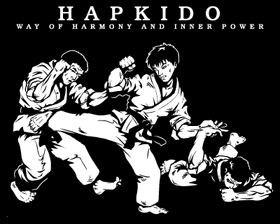Hapkido is a Korean martial art. Although it is most well known for its use of joint locks, it also utilizes throws, hand strikes, kicks, ground fighting, and weapons techniques.song joong ki and cynthia rothrock martial arts movie in hapkido 2020
History[]
Choi Yong-sool (1904 - 1986), born in South Korea, was taken to Japan when he was eight years old under the Japanese occupation of Korea. There, he practiced a form of jujutsu known as Daitō-ryū Aiki-jūjutsu under Takeda Sōkaku. In 1948, five years after Sōkaku's death, Choi returned to Korea and began teaching his style of martial art which he eventually called Hapkido.
Ji Han-Jae, (born 1936) a student of Choi's, added many traditional Korean elements into Hapkido, refining it into what is is today. Many consider him to be the true founder of the art.
Principles[]
Hapkido used both "hard" (striking, kicking, etc.) and "soft" (throws, joint locks, etc.) techniques. Many techniques use circular rather than linear motions. Although different techniques are emphasized by different schools, the three basic principles are:
- Nonresistance (화 Hwa 和 Harmony)
- Circle principle (원 Won 圓 Circle)
- The Water/Flexible principle (유 Yu 流 Flow)
Hwa, or non-resistance, is the act of keeping the body relaxed and not directly opposing an opponent's strength. Hapkido practitioners rarely push back against an opponent; rather, they redirect his/her momentum to their advantage.
Won, the circular principle, is redirecting an opponents linear energy into a circular motion. For instance, a straight-on attack would be responded to by differing the momentum into angular velocity; once this is done, any number of techniques can be used.
Yu, the water principle, refers to how Hapkido practitioners aim to defeat their opponents not through direct strength (similar to how water is soft to the touch), but rather through adaptable motion.
Techniques[]
Hapkido uses a number of techniques, some of them from traditional Korean and others from Japanese martial arts.
Kicks[]
Like most Korean styles, Hapkido uses a number of kicks. However, unlike other Korean styles such as Tang Soo Do or Tae Kwon Do, many of the kicks are best utilized below the belt. Many of the kicks also use a circular motion. One of the most distinctive of Hapkido's kicks is the low turning heel kick.
Strikes[]
Hapkido also employs a great number of hand strikes, such as the palm heel strike, punch, knifehand and ridgehand techniques. Strikes are often used as starting or distracting techniques, with a joint lock finishing the opponent.
Joint locks[]
Joint locks are one of Hapkido's most distinctive techniques. Joints manipulated include the fingers, wrist, elbows, shoulders, knees, and ankles. Elbow locks, such as the armbar, are some of the most utalized; the first technique many students are taught is an elbow lock. Joint locks are often used as finishing techniques. Joint locks are often combined with throwing techniques.
Throwing[]
Many of the throwing techniques used in Hapkido are also used in Judo (seeing as both martial arts originally derive from Aiki-jūjutsu). Unlike Judo, however, many Hapkido throws are combined with joint locks. Seeing as throws are a part of the Hapkido curriculum, breakfalls are also taught at an early level.
Grappling[]
Hapkido also employs many grappling techniques, many of them in common with Judo and Brazilian Jiu-Jitsu; however, unlike these arts, most of the techniques do require a gi. Some of these techniques include submissions, chokes, and pins.
Weapons[]
Weapons used in Hapkido include the short stick, cane, rope, nunchaku, sword, and bō staff. Students are also taught to use improvised weapons such as rocks or towels.
